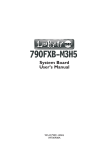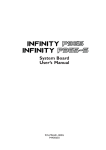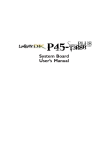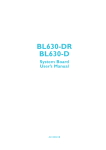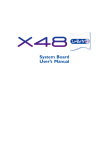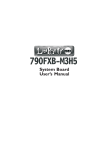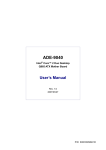Download Genicom P45 User's Manual
Transcript
System Board User’s Manual 935-DP45T1-600G 05800820E Copyright This publication contains information that is protected by copyright. No part of it may be reproduced in any form or by any means or used to make any transformation/adaptation without the prior written permission from the copyright holders. This publication is provided for informational purposes only. The manufacturer makes no representations or warranties with respect to the contents or use of this manual and specifically disclaims any express or implied warranties of merchantability or fitness for any particular purpose. The user will assume the entire risk of the use or the results of the use of this document. Further, the manufacturer reserves the right to revise this publication and make changes to its contents at any time, without obligation to notify any person or entity of such revisions or changes. © 2008. All Rights Reserved. Trademarks Windows® 2000 and Windows® XP are registered trademarks of Microsoft Corporation. Award is a registered trademark of Award Software, Inc. Other trademarks and registered trademarks of products appearing in this manual are the properties of their respective holders. FCC and DOC Statement on Class B This equipment has been tested and found to comply with the limits for a Class B digital device, pursuant to Part 15 of the FCC rules. These limits are designed to provide reasonable protection against harmful interference when the equipment is operated in a residential installation. This equipment generates, uses and can radiate radio frequency energy and, if not installed and used in accordance with the instruction manual, may cause harmful interference to radio communications. However, there is no guarantee that interference will not occur in a particular installation. If this equipment does cause harmful interference to radio or television reception, which can be determined by turning the equipment off and on, the user is encouraged to try to correct the interference by one or more of the following measures: • • • • Reorient or relocate the receiving antenna. Increase the separation between the equipment and the receiver. Connect the equipment into an outlet on a circuit different from that to which the receiver is connected. Consult the dealer or an experienced radio TV technician for help. Notice: 1. The changes or modifications not expressly approved by the party responsible for compliance could void the user's authority to operate the equipment. 2. Shielded interface cables must be used in order to comply with the emission limits. Table of Contents About this Manual................................................................................ 4 Warranty................................................................................................. 4 Static Electricity Precaution................................................................ 5 Safety Measures..................................................................................... 5 About the Package............................................................................... 6 Before Using the System Board......................................................... 6 System Board Layout............................................................................ 7 English..................................................................................................... 8 Français................................................................................................... 32 Deutsch................................................................................................... 59 Español.................................................................................................... 85 General Debug LED POST and Troubleshooting ........................ 111 1 Introduction About this Manual An electronic file of this manual is included in the CD. To view the user’s manual in the CD, insert the CD into a CD-ROM drive. The autorun screen (Main Board Utility CD) will appear. Click the “TOOLS” icon then click “Manual” on the main menu. For additional information on the system board, please download the complete version of the manual from DFI’s website. Visit www.dfi.com. Warranty 1. Warranty does not cover damages or failures that arised from misuse of the product, inability to use the product, unauthorized replacement or alteration of components and product specifications. 2. The warranty is void if the product has been subjected to physical abuse, improper installation, modification, accidents or unauthorized repair of the product. 3. Unless otherwise instructed in this user’s manual, the user may not, under any circumstances, attempt to perform service, adjustments or repairs on the product, whether in or out of warranty. It must be returned to the purchase point, factory or authorized service agency for all such work. 4. We will not be liable for any indirect, special, incidental or consequencial damages to the product that has been modified or altered. 4 Introduction 1 Static Electricity Precautions It is quite easy to inadvertently damage your PC, system board, components or devices even before installing them in your system unit. Static electrical discharge can damage computer components without causing any signs of physical damage. You must take extra care in handling them to ensure against electrostatic build-up. 1. To prevent electrostatic build-up, leave the system board in its anti-static bag until you are ready to install it. 2. Wear an antistatic wrist strap. 3. Do all preparation work on a static-free surface. 4. Hold the device only by its edges. Be careful not to touch any of the components, contacts or connections. 5. Avoid touching the pins or contacts on all modules and connectors. Hold modules or connectors by their ends. Important: Electrostatic discharge (ESD) can damage your processor, disk drive and other components. Perform the upgrade instruction procedures described at an ESD workstation only. If such a station is not available, you can provide some ESD protection by wearing an antistatic wrist strap and attaching it to a metal part of the system chassis. If a wrist strap is unavailable, establish and maintain contact with the system chassis throughout any procedures requiring ESD protection. Safety Measures To avoid damage to the system: • Use the correct AC input voltage range.. To reduce the risk of electric shock: • Unplug the power cord before removing the system chassis cover for installation or servicing. After installation or servicing, cover the system chassis before plugging the power cord. Battery: • Danger of explosion if battery incorrectly replaced. • Replace only with the same or equivalent type recommend by the manufacturer. • Dispose of used batteries according to local ordinance. 5 1 Introduction About the Package The system board package contains the following items. If any of these items are missing or damaged, please contact your dealer or sales representative for assistance. ; ; ; ; ; ; ; ; ; The system board A user’s manual One IDE cable One FDD cable Two Serial ATA data cables One power cable with 2 Serial ATA power connectors One RAID floppy diskette One I/O shield One “Mainboard Utility” CD The system board and accessories in the package may not come similar to the information listed above. This may differ in accordance to the sales region or models in which it was sold. For more information about the standard package in your region, please contact your dealer or sales representative. Before Using the System Board Before using the system board, prepare basic system components. If you are installing the system board in a new system, you will need at least the following internal components. • • • A CPU Memory module Storage devices such as hard disk drive, CD-ROM, etc. You will also need external system peripherals you intend to use which will normally include at least a keyboard, a mouse and a video display monitor. 6 Introduction 1 System Board Layout 1 Mouse KB PS/2 power select (JP7) CPU FSB select (JP17-JP19) 12V power 1 1 1 1 JP19 JP17 JP18 CPU fan 1 ATX power Optical S/PDIF-out 12 24 Coaxial RCA S/PDIF-out Clear CMOS (JP8) 1 USB 9 USB 8 USB 6-11 power select (JP5) DRAM Power LED Socket 775 1 USB 11 USB 10 1 13 IDE LAN USB 7 USB 6 1 Center/ Subwoofer Rear R/L Side R/L Intel NB Fan Marvell 88E8053 Line-in Front R/L Mic-in P45 1 1 CD-in PCIE 1 Realtek ALC885 1 DIMM 1 DIMM 2 5V/12V power Front audio Clear CMOS (JP2) PCIE 3 IrDA 1 JMicron JMB368 PCIE 2 1 1 DIMM 3 DIMM 4 5V/12V power PCIE 4 1 Secondary RTC reset (JP12) Intel ICH10R 1 SATA 1 SATA 0 SATA 3 SATA 2 PCI 1 ITE IT8718F Download Flash BIOS (JP13) Battery PCI 2 2 8 1 7 SPI Flash BIOS Power Reset SATA 5 SATA 4 USB 0-5 power select (JP6) COM 1 1 Standby Power LED 1 FDD USB 4-5 USB 2-3 Chassis fan USB 0-1 System fan 1 1 1 1 1 1 Front panel 7 E English English Chapter 1 - Introduction 8 Specifications Processor • LGA 775 socket for: - Intel® CoreTM2 Quad and Intel® CoreTM2 Duo • Supports Intel Enhanced Memory 64 Technology (EMT64T) • Supports Enhanced Intel SpeedStep Technology (EIST) • Supports Intel Hyper-Threading Technology • Supports 1333/1066/800MHz FSB Chipset • Intel® chipset - Northbridge: Intel® P45 Express chipset Intel® Fast Memory Access technology - Southbridge: Intel® ICH10R System Memory • Four 240-pin DDR2 DIMM sockets • Supports DDR2 667/800 MHz • Delivers up to 12.8Gb/s bandwidth • Supports dual channel (128-bit wide) memory interface • Supports up to 8GB system memory • Supports unbuffered x8 and x16 DIMMs Expansion Slots • 2 PCI Express (Gen 2) x16 slots - 2-way CrossFire: One slot operating at x16 (16-lane port) or two slots each operating at x8 (8-lane ports) bandwidth • 2 PCI Express x1 slots • 2 PCI slots BIOS • Award BIOS • 8Mbit SPI flash BIOS • CMOS Reloaded Audio • Realtek ALC885 High Definition audio CODEC • 8-channel audio output • DAC SNR/ADC SNR of 106dB/101dB • Full-rate lossless content protection technology • Optical S/PDIF-out and coaxial RCA S/PDIF-out interfaces LAN • Marvell 88E8053 PCIE Gigabit LAN controller • Fully compliant to IEEE 802.3 (10BASE-T), 802.3u (100BASETX) and 802.3ab (1000BASE-T) standards IDE • JMicron JMB368 PCI Express to PATA host controller • Supports up to 2 UltraDMA 33/66/100Mbps IDE devices Serial ATA with RAID • Intel Matrix Storage technology • Supports up to 6 SATA devices • SATA speed up to 3Gb/s • RAID 0, RAID 1, RAID 0+1 and RAID 5 Rear Panel I/O • 1 mini-DIN-6 PS/2 mouse port • 1 mini-DIN-6 PS/2 keyboard port • 1 optical S/PDIF-out port • 1 coaxial RCA S/PDIF-out port • 6 USB 2.0/1.1 ports • 1 RJ45 LAN port • Center/subwoofer, rear R/L and side R/L jacks • Line-in, line-out (front R/L) and mic-in jacks Internal I/O • 3 connectors for 6 additional external USB 2.0 ports • 1 connector for an external COM port • 1 front audio connector • 1 CD-in connector • 1 IrDA connector • 6 Serial ATA connectors • 1 40-pin IDE connector • 1 floppy connector • 1 24-pin ATX power connector • 1 8-pin 12V power connector • 2 4-pin 5V/12V power connectors (FDD type) • 1 front panel connector • 4 fan connectors • 1 download flash BIOS connector • 1 diagnostic LED • EZ touch switches (power switch and reset switch) E English English Power Management • ACPI and OS Directed Power Management • ACPI STR (Suspend to RAM) function • Wake-On-PS/2 Keyboard/Mouse • Wake-On-USB Keyboard/Mouse • Wake-On-LAN • Wake-On-Ring • RTC timer to power-on the system • AC power failure recovery Hardware Monitor • Monitors CPU/system/Northbridge temperature and overheat alarm • Monitors Vcore/Vdimm/Vnb/VCC5/12V/V5sb/Vbat voltages • Monitors the speed of the cooling fans • CPU Overheat Protection function monitors CPU temperature and fan during system boot-up - automatic shutdown upon system overheat PCB • 4 layers, ATX form factor • 24.5cm (9.64") x 30.5cm (12") 9 E English English Chapter 2 - Hardware Installation Jumper Settings Clear CMOS Data Clearing CMOS Data using Jumpers JP8 2 3 2 1 1 3 X 1-2 On: Normal 2-3 On: (default) Clear CMOS Data JP2 1 2 3 1 2 3 X 2-3 On: 1-2 On: Normal Clear CMOS Data (default) If you encounter the following, a) CMOS data becomes corrupted. b) You forgot the supervisor or user password. c) The overclocked settings in the BIOS resulted to the system’s instability or caused system boot up problems. you can reconfigure the system with the default values stored in the ROM BIOS. JP8 is accessible from the rear panel of the system. This provides convenience by allowing you to clear the CMOS without having to remove the chassis cover. 10 To load the default values stored in the ROM BIOS, please follow the steps below. 1. Power-off the system then unplug the power cord. 2. Set JP2 or JP8 pins 2 and 3 to On. Wait for a few seconds and set JP2 or JP8 back to its default setting, pins 1 and 2 On. E English English 3. Now plug the power cord then power-on the system. 11 E English English PS/2 Power Select JP7 1 X 2 3 1 1-2 On: 5V (default) 2 3 2-3 On: 5VSB Important: The 5VSB power source of your power supply must suppor t ≥720mA. Selecting 5VSB will allow you to use the PS/2 keyboard or PS/2 mouse to wake up the system. USB Power Select USB 6-11 (JP5) X 1 2 3 1-2 On: 5V (default) 3 USB 0-5 (JP6) X 1-2 2 1 On: 5V (default) 1 2 3 2-3 On: 5VSB 3 2 1 2-3 On: 5VSB Selecting 5VSB will allow you to use the USB keyboard or USB mouse to wake up the system. Important: The 5VSB power source of your power supply must support ≥1.5A (2 devices) or ≥2A (3 or more devices). 12 English E 1 2 X 3 4 JP19 JP18 JP17 English CPU FSB Select By default, the three jumpers are all set to pins 1 and 2 On. This setting will allow the system to automatically run according to the CPU’s FSB. If you want to change the settings, please refer to the table below. By CPU FSB 800 FSB 1066 FSB 1333 JP17 1-2 On 2-3 On 2-3 On 2-3 On JP18 1-2 On 3-4 On 2-3 On 2-3 On JP19 1-2 On 2-3 On 2-3 On 3-4 On 13 E English English Secondary RTC Reset JP12 1 2 3 1 2 3 X 1-2 On: Normal (default) 2-3 On: RTC reset When the RTC batter y is removed, this jumper resets the manageability register bits in the RTC. Note: 1. The SRTCRST# input must always be high when all other RTC power planes are on. 2. In the case where the RTC battery is dead or missing on the platform, the SRTCRST# pin must rise before the RSMRST# pin. Rear Panel I/O Ports Center/ Subwoofer Rear R/L PS/2 Mouse LAN Line-in Front R/L Mic-in USB 8-9 USB 10-11 Coaxial Side R/L S/PDIF-out USB 6-7 Clear Optical CMOS S/PDIF-out jumper PS/2 K/B 14 English E PS/2 Mouse English PS/2 Ports and S/PDIF Ports W W PS/2 KB Optical S/PDIF Coaxial RCA S/PDIF PS/2 Mouse and PS/2 Keyboard Ports These ports are used to connect a PS/2 mouse and a PS/2 keyboard. Optical S/PDIF The optical S/PDIF jack is used to connect an external audio output device using an optical S/PDIF cable. Coaxial RCA S/PDIF The coaxial RCA S/PDIF jack is used to connect an external audio output device using a coaxial S/PDIF cable. Important: DO NOT use optical S/PDIF and Coaxial RCA S/PDIF at the same time. 15 E English English USB Ports and LAN Port USB 9 USB 8 W USB 11 W W USB 10 LAN USB 7 VCC -Data +Data GND N. C. USB 6 USB 2-3 10 9 VCC -Data +Data GND Key USB 0-1 USB 4-5 2 1 USB Ports The USB ports are used to connect USB 2.0/1.1 devices. The 10-pin connectors allow you to connect 6 additional USB 2.0/1.1 ports. Your USB ports may come mounted on a card-edge bracket. Install the card-edge bracket to an available slot at the rear of the system chassis then connect the USB port cables to these connectors. LAN Port The LAN port allows the system board to connect to a local area network by means of a network hub. 16 English E English Audio and CD-In Rear audio Center/ Subwoofer Line-in Front R/L Side R/L Mic-in W 10 9 Mic-L Mic-R Line-out-R Front-sense Line-out-L 2 1 W Front audio W GND Presense-signal Mic-jack-sense Key Line-out-jack-sense Rear R/L 4 Right audio channel Ground Ground Left audio channel CD-in 1 Rear Panel Audio Center/Subwoofer Jack (Orange) This jack is used to connect to the center and subwoofer speakers of the audio system. Rear Right/Left Jack (Black) This jack is used to connect to the rear right and rear left speakers of the audio system. Side Right/Left Jack (Gray) This jack is used to connect to the side left and side right speakers of the audio system. Line-in (Light Blue) This jack is used to connect any audio devices such as Hi-fi set, CD player, tape player, AM/FM radio tuner, synthesizer, etc. Line-out - Front Right/Left Jack (Lime) This jack is used to connect to the front right and front left speakers of the audio system. 17 English E English Mic-in Jack (Pink) This jack is used to connect an external microphone. Front Audio The front audio connector is used to connect to the line-out and mic-in jacks that are at the front panel of your system. CD-in The CD-in connector is used to receive audio from a CD-ROM drive, TV tuner or MPEG card. Internal I/O Connectors Serial ATA Connectors SATA 0-1 SATA 2-3 SATA 4-5 The Serial ATA (SATA) connectors are used to connect Serial ATA drives. Connect one end of the Serial ATA cable to a Serial ATA connector and the other end to your Serial ATA device. Configuring RAID Refer to the RAID chapter in this manual for more information about creating RAID on Serial ATA drives. 18 English E English FDD Connector and IDE Connector 39 40 X 2 1 IDE 1 2 X 33 43 FDD FDD Connector The floppy disk drive connector is used to connect a floppy drive. Insert one end of the floppy cable into this connector and the other end-most connector to the floppy drive. The colored edge of the cable should align with pin 1 of this connector. IDE Connector The IDE disk drive connector is used to connect 2 IDE disk drives. An IDE cable have 3 connectors on them, one that plugs into this connector and the other 2 connects to IDE devices. The connector at the end of the cable is for the Master drive and the connector in the middle of the cable is for the Slave drive. The colored edge of the cable should align with pin 1 of this connector. Note: When using two IDE drives, one must be set as the master and the other as the slave. Follow the instructions provided by the drive manufacturer for setting the jumpers and/or switches on the drives. 19 E English English IrDA and Serial (COM) Connectors IRRX N. C. Ground VCC IRTX 5 X 1 RD DTR DSR CTS IrDA COM 2 1 W CD TD GND RTS RI 9 IrDA Connector This connector is used to connect an IrDA module. Note: The sequence of the pin functions on some IrDA cable may be reversed from the pin function defined on the system board. Make sure to connect the cable connector to the IrDA connector according to their pin functions. You may need to install the proper drivers in your operating system to use the IrDA function. Refer to your operating system’s manual or documentation for more information. Serial (COM) Connector The serial (COM) connector is used to connect modems, serial printers, remote display terminals, or other serial devices. Your COM port may come mounted on a card-edge bracket. Install the card-edge bracket to an available slot at the rear of the system chassis then connect the serial port cable to this connector. The colored edge of the cable should align with pin 1 of this connector. 20 English E Sense Power Speed Control Ground X 4 1 3 NB fan 3 CPU fan On/Off Power Sense X 1 English Cooling Fan Connectors 3 1 Sense Ground Power System fan 1 Sense Ground Power X Chassis fan X These fan connectors are used to connect cooling fans. Cooling fans will provide adequate airflow throughout the chassis to prevent overheating the CPU and system board components. EZ Touch Switches X Power Reset The presence of the power switch and reset switch on the system board are user-friendly especially to DIY users. They provide convenience in powering on and/or resetting the system while fine tuning the system board before it is installed into the system chassis. 21 E English English LEDs DRAM Power LED Standby Power LED Diagnostic LED DRAM Power LED This LED will light when the system’s power is on. Standby Power LED This LED will light when the system is in the standby mode. Diagnostic LED The Diagnostic LED displays POST codes. POST (Power-On Self Tests) which is controlled by the BIOS is performed whenever you power-on the system. POST will detect the status of the system and its components. Each code displayed on the LED corresponds to a certain system status. . . . . . . 22 . . Warning: When the DRAM Power LED and/or Standby Power LED lit red, it indicates that power is present on the DIMM sockets and/or PCI slots. Power-off the PC then unplug the power cord prior to installing any memory modules or add-in cards. Failure to do so will cause severe damage to the motherboard and components. English E Use a power supply that complies with the ATX12V Power Supply Design Guide Version 1.1. An ATX12V power supply unit has a standard 24-pin ATX main power connector that must be inserted into this connector. English Power Connectors 12 24 COM +5VDC +5VDC +5VDC NC COM COM COM PS_ON# COM -12VDC +3.3VDC +3.3VDC X +12VDC +12VDC +5VSB PWR_OK COM +5VDC COM +5VDC COM +3.3VDC +3.3VDC 1 13 Your power supply unit may come with an 8-pin or 4-pin +12V power connector. The +12V power enables the delivery of more +12VDC current to the processor’s Voltage Regulator Module (VRM). If available, it is preferable to use the 8-pin power; otherwise connect a 4-pin power to this connector. X +12V 5 1 8 4 Ground 23 English E English The power connectors from the power supply unit are designed to fit the 24-pin and 8-pin connectors in only one orientation. Make sure to find the proper orientation before plugging the connectors. The FDD-type power connectors are additional power connectors. If you are using more than one graphics cards, we recommend that you plug a power cable from your power supply unit to the 5V/12V power connector. This will provide more stability to the entire system. The system board will still work even if the additional power connector is not connected. 1 4 +5V +12V Ground Ground The system board requires a minimum of 300 Watt power supply to operate. Your system configuration (CPU power, amount of memory, add-in cards, peripherals, etc.) may exceed the minimum power requirement. To ensure that adequate power is provided, we strongly recommend that you use a minimum of 400 Watt (or greater) power supply. Important: Insufficient power supplied to the system may result in instability or the add-in boards and peripherals not functioning properly. Calculating the system’s approximate power usage is important to ensure that the power supply meets the system’s consumption requirements. 24 English E Normally, you can power-off the PC by: 1. Pressing the power button at the front panel of the chassis. or 2. Pressing the power switch that is on the system board (note: not all system boards come with this switch). English Restarting the PC If for some reasons you need to totally cut off the power supplied to the PC, switch off the power supply or unplug the power cord. Take note though that if you intend to restart it at once, please strictly follow the steps below. 1. The time where power is totally discharged varies among power supplies. It's discharge time is highly dependent on the system's configuration such as the wattage of the power supply, the sequence of the supplied power as well as the number of peripheral devices connected to the system. Due to this reason, we strongly recommend that you wait for the Standby Power LED (refer to the “LEDs” section in this chapter for the location of the Standby Power LED) to lit off. 2. After the Standby Power LED has lit off, wait for 6 seconds before powering on the PC. If the system board is already enclosed in a chassis which apparently will not make the Standby Power LED visible, wait for 15 seconds before you restore power connections. 15 seconds is approximately the time that will take the LED to lit off and the time needed before restoring power. The above will ensure protection and prevent damage to the motherboard and components. 25 E English English Front Panel Connectors SPEAKER RESET HD-LED 1 2 19 X 20 PWR-LED ATX-SW HD-LED: Primary/Secondary IDE LED This LED will light when the hard drive is being accessed. RESET: Reset Switch This switch allows you to reboot without having to power off the system thus prolonging the life of the power supply or system. SPEAKER: Speaker Connector This connects to the speaker installed in the system chassis. ATX-SW: ATX Power Switch Depending on the setting in the BIOS setup, this switch is a “dual function power button” that will allow your system to enter the SoftOff or Suspend mode. 26 PWR-LED: Power/Standby LED When the system’s power is on, this LED will light. When the system is in the S1 (POS - Power On Suspend) or S3 (STR - Suspend To RAM) state, it will blink every second. Note: If a system did not boot-up and the Power/Standby LED did not light after it was powered-on, it may indicate that the CPU or memor y module was not installed properly. Please make sure they are properly inserted into their corresponding socket. Pin E English English Pin Assignment HD-LED (Primary/Secondary IDE LED) 3 5 HDD LED Power HDD Reserved 14 16 N. C. N. C. ATX-SW (ATX power switch) 8 10 PWRBT+ PWRBT- Reserved 18 20 N. C. N. C. RESET (Reset switch) 7 9 Ground H/W Reset SPEAKER (Speaker connector) 13 15 17 19 Speaker Data N. C. Ground Speaker Power PWR-LED (Power/Standby LED) 2 4 6 LED Power (+) LED Power (+) LED Power (-) or Standby Signal 27 E English English PCI Express Slots PCI Express x1 PCI Express x16 PCI Express x1 PCI Express x16 GROUND SPI_CLK SPI_MOSI Download Flash BIOS Connector 8 7 SPI_VCC3 SPI_CS0B SPI_MIS0 SPI_HOLD# 2 1 28 W English E The Intel ICH10R chip alows configuring RAID on Serial ATA drives. It supports RAID 0, RAID 1, RAID 0+1 and RAID 5. English Chapter 3 - RAID RAID Levels RAID 0 (Striped Disk Array without Fault Tolerance) RAID 0 uses two new identical hard disk drives to read and write data in parallel, interleaved stacks. Data is divided into stripes and each stripe is written alternately between two disk drives. This improves the I/O performance of the drives at different channel; however it is not fault tolerant. A failed disk will result in data loss in the disk array. RAID 1 (Mirroring Disk Array with Fault Tolerance) RAID 1 copies and maintains an identical image of the data from one drive to the other drive. If a drive fails to function, the disk array management software directs all applications to the other drive since it contains a complete copy of the drive’s data. This enhances data protection and increases fault tolerance to the entire system. Use two new drives or an existing drive and a new drive but the size of the new drive must be the same or larger than the existing drive. RAID 0+1 (Striping and Mirroring) RAID 0+1 is a combination of data striping and data mirroring providing the benefits of both RAID 0 and RAID 1. Use four new drives or an existing drive and three new drives for this configuration. RAID 5 RAID 5 stripes data and parity information across hard drives. It is fault tolerant and provides better hard drive performance and more storage capacity. Settings To enable the RAID function, the following settings are required. 1. 2. 3. 4. 5. Connect the Serial ATA drives. Configure Serial ATA in the Award BIOS. Configure RAID in the RAID BIOS. Install the RAID driver during OS installation. Install the Intel Matrix Storage Manager 29 E English English Step 1: Connect the Serial ATA Drives Refer to chapter 2 for details on connecting the Serial ATA drives. Important: 1. Make sure you have installed the Serial ATA drives and connected the data cables otherwise you won’t be able to enter the RAID BIOS utility. 2. Treat the cables with extreme caution especially while creating RAID. A damaged cable will ruin the entire installation process and operating system. The system will not boot and you will lost all data in the hard drives. Please give special attention to this warning because there is no way of recovering back the data. Step 2: Configure Serial ATA in the Award BIOS 1. Power-on the system then press <Del> to enter the main menu of the Award BIOS. 2. Select the Integrated Peripherals submenu - OnChip IDE Device section of the BIOS. 3. Configure Serial ATA in the appropriate fields. 4. Press <Esc> to return to the main menu of the BIOS setup utility. Select “Save & Exit Setup” then press <Enter>. 5. Type <Y> and press <Enter>. 6. Reboot the system. Step 3: Configure RAID in the RAID BIOS When the system powers-up and all drives have been detected, the Intel RAID BIOS status message screen will appear. Press the <Ctrl> and <I> keys simultaneously to enter the utility. The utility allows you to build a RAID system on Serial ATA drives. 30 English E The RAID driver must be installed during the Windows® XP or Windows® 2000 installation using the F6 installation method. This is required in order to install the operating system onto a hard drive or RAID volume when in RAID mode or onto a hard drive when in AHCI mode. 1. 2. 3. 4. 5. English Step 4: Install the RAID Driver During OS Installation Start Windows Setup by booting from the installation CD. Press <F6> when prompted in the status line with the ‘Press F6 if you need to install a third party SCSI or RAID driver’ message. Press <S> to “Specify Additional Device”. At this point you will be prompted to insert a floppy disk containing the RAID driver. Insert the provided RAID driver diskette. Locate for the drive where you inserted the diskette then select RAID or AHCI controller that corresponds to your BIOS setup. Press <Enter> to confirm. You have successfully installed the driver. However you must continue installing the OS. Leave the floppy disk in the floppy drive until the system reboots itself because Windows setup will need to copy the files again from the floppy disk to the Windows installation folders. After Windows setup has copied these files again, remove the floppy diskette so that Windows setup can reboot as needed. Step 5: Install the Intel Matrix Storage Manager The Intel Matrix Storage Manager can be installed from within Windows. It allows RAID volume management (create, delete, migrate) from within the operating system. It will also display useful SATA device and RAID volume information. The user interface, tray icon service and monitor service allow you to monitor the current status of the RAID volume and/or SATA drives. It enables enhanced performance and power management for the storage subsystem. 1. 2. 3. 4. Insert the CD into a CD-ROM drive. On the left side of the autorun screen, click the “CHIPSET” icon. Click “Intel(R) Matrix Storage Manager” on the main menu. Follow the steps shown on the screen; clicking “next” each time you finish a step. 31 Français F Français Chapitre 1 - Spécifications Processeur Chipset 32 • LGA 775 socket pour: - Intel® CoreTM2 Quad et Intel® CoreTM2 Duo • Intel Ont augmenté La Technologie De la Mémoire 64 (EMT64T) • Ont augmenté La Technologie D’Intel SpeedStep (EIST) • Intel Hyper-Filetant La Technologie (Intel Hyper-Threading) • Soutient 1333/1066/800MHz FSB • Intel® chipset - Pont nord: Intel® P45 Express chipset La technologie rapide d’accès mémoire d’Intel - Pont sud: Intel® ICH10R Mémoire Système • 4 sockets DIMM DDR2 240-pin • Les modules DIMM 667/800 MHz • Jusqu’à 12.8GB/s bande passante • L’interface de mémoire deux canaux (128-bit) • Jusqu’à 8GB de mémoire système • Non-tamponns DIMM x8 et x16 Logements d’Extension • 2 PCI Express (Gen 2) x16 fentes (PCIE 2 et PCIE 4) - CrossFire bi directionnel: x8 (PCIE 2) + x8 (PCIE 4) - 1 carte graphique: x16 (PCIE 2/PCIE 4) • 2 PCI Express x1 slot • 2 PCI slots BIOS • Comp



















































































































